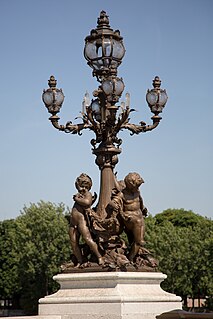 W
WA street light, light pole, lamppost, street lamp, light standard or lamp standard is a raised source of light on the edge of a road or path. Similar lights may be found on a railway platform. When urban electric power distribution became ubiquitous in developed countries in the 20th century, lights for urban streets followed, or sometimes led.
 W
WThe Cincinnati Street Gas Lamps are a historic district in Cincinnati, Ohio, United States. Composed of more than 1,100 street lamps scattered throughout the city, the district was added to the National Register of Historic Places in 1978.
 W
WDolphin lamp standards provide electric light along much of the Thames Embankment in London, United Kingdom. Two stylised dolphins or sturgeons writhe around the base of a standard lamp post, supporting a fluted column bearing electric lights in an opaque white globe, topped by a metal crown. Many of the lamps are mounted on granite plinths.
 W
WAn LED street light or road light is an integrated light-emitting diode (LED) light fixture that is used for street lighting.
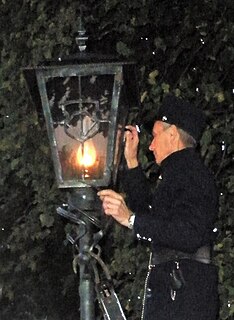 W
WA lamplighter is a person employed to light and maintain candle or, later, gas street lights. Very few exist today as most gas street lighting has long been replaced by electric lamps.
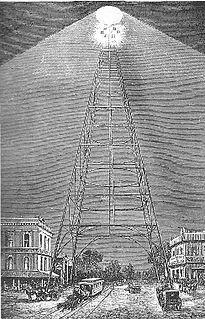 W
WA moonlight tower or moontower is a lighting structure designed to illuminate areas of a town or city at night.
 W
WThe moonlight towers in Austin, Texas, are the only known surviving moonlight towers in the world. They are 165 feet (50 m) tall and have a 15-foot (4.6 m) foundation. A single tower cast light from six carbon arc lamps, illuminating a 1,500-foot-radius (460 m) circle brightly enough to read a watch.
 W
WNEMA wattage labels are used on street lighting fixtures to indicate the wattage of the lamp for maintenance purposes, with various colors showing what type the lamp uses.
 W
WReality Checkpoint is a large cast-iron lamppost in the middle of Parker's Piece, Cambridge, England, at the intersection of the park's diagonal paths.
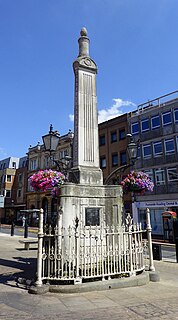 W
WThe Simeon Monument, also known as the Soane Obelisk, the Soane Monument and the Simeon Obelisk, is a stone structure in Market Place, the former site of the market in Reading, Berkshire. It was commissioned by Edward Simeon, a Reading-born merchant who became extremely wealthy as a City of London trader. Edward Simeon's brother John Simeon was a former Member of Parliament for Reading who had lost his seat in the 1802 elections to the parliament of the newly created United Kingdom of Great Britain and Ireland, since which time the family had been engaged in ostentatious spending locally in an effort to gain support among the town's voters. Although street lighting had been installed in Reading in 1797, the system used was one of lamps attached to the sides of buildings and as a consequence open spaces remained unlit. In 1804 Simeon persuaded the Mayor of Reading that it would be of benefit to erect a structure in Market Place, which would serve both to carry lamps to light the area and to improve the flow of traffic in the area, and volunteered to pay for such a structure himself.
 W
WA sodium-vapor lamp is a gas-discharge lamp that uses sodium in an excited state to produce light at a characteristic wavelength near 589 nm.
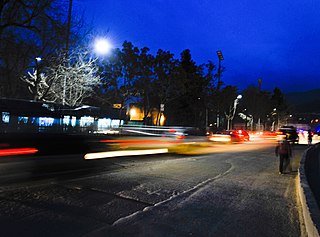 W
WSolar street lights are raised light sources which are powered by solar panels generally mounted on the lighting structure or integrated into the pole itself. The solar panels charge a rechargeable battery, which powers a fluorescent or LED lamp during the night.
 W
WStreet Light is a painting by Italian Futurist painter Giacomo Balla, dated 1909, depicting an electric street lamp casting a glow which outshines the crescent moon. The painting was inspired by streetlights at the Piazza Termini in Rome.
 W
WStreet light interference (SLI) is a term coined by paranormal author Hilary Evans to denote the claimed ability of individuals to turn street lights or outside building security lights on or off when passing near them. Believers in SLI allege that they experience it on a regular basis with specific lamps and street lights and more frequently than chance would explain; however, SLI has never been demonstrated to occur in a scientific experiment, and those who claim the ability have been found to be unable to reproduce the effect on demand.
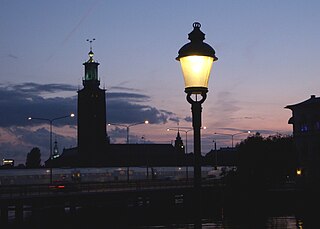 W
WStreet lighting in Stockholm was a private affair for many centuries. The first known decree regarded lighting in Sweden is from 1697 and concerned Riddarholmen in Stockholm. A royal decree regarding public street lighting was issued in 1749 and asked property owners to keep lanterns lit during the dark months from dusk to midnight, with bright moon nights as an exception. Stockholm was a dark city, especially at night when the street lanterns were extinguished. People avoided walking on the city streets during the nighttime. The public street lighting in Stockholm became a communal task when gas lanterns and later on electrical lamps were introduced during the mid 1800s. The city contributed 97 lanterns which were placed on the city's buildings, on public places, by docks, and bridges.
 W
WStreet lighting in the District of Columbia is provided by the District of Columbia Department of Transportation, and covers all city streets and alleys in Washington, D.C., in the United States. Because the Constitution of the United States makes the District of Columbia a creature of the United States federal government, the federal government has the authority to regulate the type and appearance of street lighting. The United States Congress has delegated a part of this authority to the United States Commission of Fine Arts, which controls the appearance of lighting standards in certain areas of the city.
 W
WUrban Light (2008) is a large-scale assemblage sculpture by Chris Burden located at the Wilshire Boulevard entrance to the Los Angeles County Museum of Art. The 2008 installation consists of restored street lamps from the 1920s and 1930s. Most of them once lit the streets of Southern California.